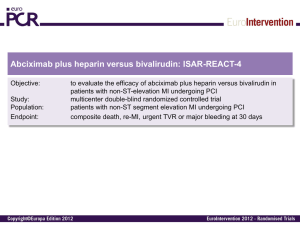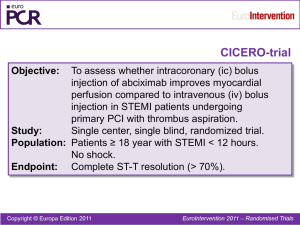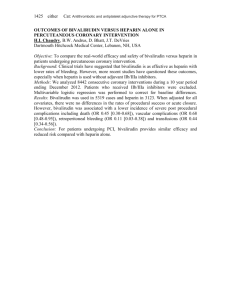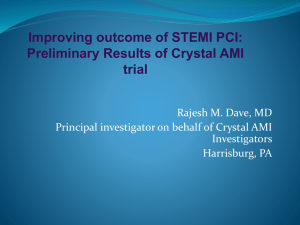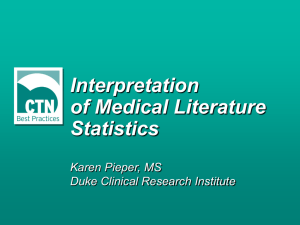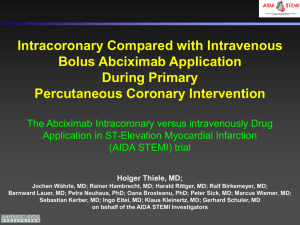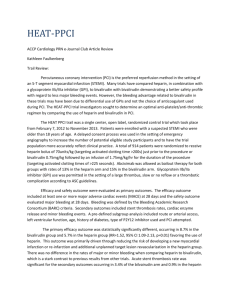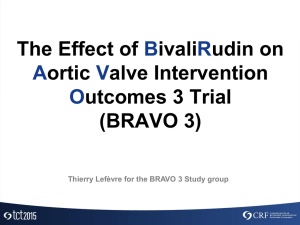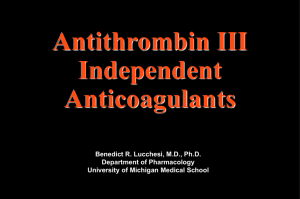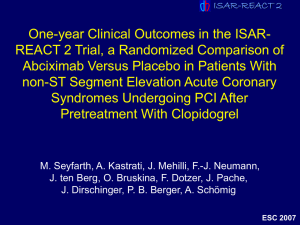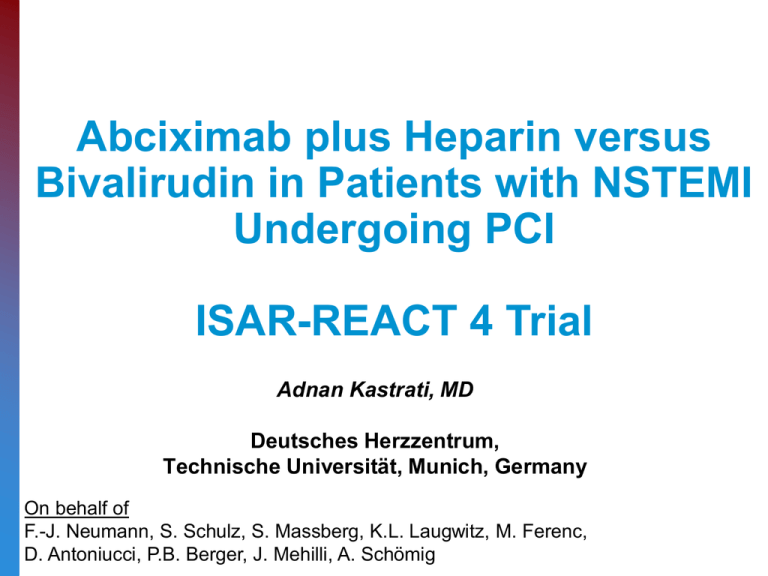
Abciximab plus Heparin versus
Bivalirudin in Patients with NSTEMI
Undergoing PCI
ISAR-REACT 4 Trial
Adnan Kastrati, MD
Deutsches Herzzentrum,
Technische Universität, Munich, Germany
On behalf of
F.-J. Neumann, S. Schulz, S. Massberg, K.L. Laugwitz, M. Ferenc,
D. Antoniucci, P.B. Berger, J. Mehilli, A. Schömig
Conflicts of interest
Speaker fees/honoraria from:
• Abbott
• Astra-Zeneca
• Bristol-Myers
• Cordis
• Daichii Sankyo/Lilly
• Medtronic
Background
• Abciximab, a GP IIb/IIIa inhibitor, has improved the
results of PCI in patients with ACS
ISAR-REACT 2, JAMA 2006
Death/MI/UTVR, %
Death/MI/UTVR, %
15
20
11.9%
Troponin-Positive: RR=0.71 [0.54-0.95]
15
8.9%
10
10
Abciximab vs. Placebo
5
RR = 0.75 [95% CI, 0.58-0.97]
Abciximab vs. Placebo
Troponin-Negative: RR=0.99 [0.56-1.76]
5
0
0
0
5
10
15
20
25
30
Days after randomization
0
5
10
15
20
25
30
Days after randomization
Background
• Bivalirudin, a direct thrombin inhibitor, has been superior to
GP IIb/IIIa inhibitors plus heparins in patients with ACS
ACUITY, NEJM 2006
Background
Relevant issues with the ACUITY trial
•
Open-label trial
•
40% of the patients without elevated troponin
•
PCI in <60% of the patients
•
Control group: a mixture of UFH/Enoxaparin and
3 GP IIb/IIIa inhibitors (only 9% abciximab)
•
Liberal definition of bleeding (including 5 cm hematomas)
Rationale of ISAR-REACT 4 trial
The combination of abciximab and unfractionated heparin has
not been compared with bivalirudin in dedicated studies
involving patients with NSTEMI undergoing PCI
Objective of ISAR-REACT 4 trial
to determine whether the combination of abciximab with
unfractionated heparin, as compared with bivalirudin,
improves the clinical outcomes in patients with acute NSTEMI
undergoing PCI
Study organization
Steering committee:
A. Schömig (Chairman), A. Kastrati (PI), F.J. Neumann, P.B. Berger
Participating centers:
Germany
• Deutsches Herzzentrum, Munich (PI: S. Massberg)
• Herz-Zentrum, Bad Krozingen (PI: F.J. Neumann)
• 1. Med. Klinik, Klinikum rechts der Isar, Munich (PI: K.L. Laugwitz)
• Vivantes Auguste-Viktoria-Klinikum, Berlin (PI: H. Schühlen)
• Uniklinik, Tübingen (PI: M. Gawaz)
• Vivantes Klinikum Neukölln, Berlin (PI: H. Darius)
US
• Geisinger Clinic, Danville, PA (PI: P.B. Berger)
Italy
• Careggi Hospital, Florence (PI: D. Antoniucci)
Inclusion criteria
• Age between 19 and 80 years;
• unstable angina within the preceding 48 hours;
• elevated levels of cardiac biomarkers (troponin or CK MB);
• and coronary stenoses requiring PCI
Main exclusion criteria
• STEMI within 48 hours from symptom onset;
• cardiogenic shock;
• active bleeding or a bleeding diathesis;
• a planned staged PCI procedure within 30 days;
• glomerular filtration rate <30 ml/min or creatinine >30 mg/L;
• receipt of coumarin within 7d, a GP IIb/IIIa inhibitor within
14d, UFH within 4h, LMWH within 8 h, and bivalirudin within
24h
Primary endpoint
A composite of death, large myocardial infarction or urgent
target vessel revascularization within 30 days
(large MI: new Q waves or CK-MB elevation >5 times above ULN)
Secondary endpoints
Efficacy
A composite of death, any myocardial infarction or urgent target
vessel revascularization within 30 days
(any MI: new Q waves or CK-MB elevation >3 times above ULN)
Safety
Major bleeding within 30 days
(intracranial, intraocular, or retroperitoneal; Hb decrease >40g/L plus either overt
bleeding or need for transfusion of 2 or more units)
Sample size calculation
• 30% reduction of the incidence of the 1°endpoint
with abciximab plus heparin
- abciximab plus heparin: 10.7%
- bivalirudin: 15.3%
• 2-sided α-level: 5%
• Power: 80%
1,700 patients
Trial flow-chart
1,721 Pts with NSTEMI
Pre-treated with 600 mg of clopidogrel
861 pts
Abciximab
Double-blind
(double-dummy drug)
Bolus of 0.25 mg/kg
Infusion of 0.125 μg/kg/min for 12h
Unfractionated heparin
860 pts
Bivalirudin
Bolus of 0.75 mg/kg
Infusion of 1.75 mg/kg/hr
for duration of PCI
Bolus of 70 U/kg
No PCI:
2 patients
2 patients
Baseline characteristics
Abciximab
n=861
Bivalirudin
n=860
67.5±11.2
67.5±10.8
Women, %
Hypercholesterolemia, %
23.2
69.7
23.1
67.4
Arterial hypertension, %
Diabetes mellitus, %
86.5
29.8
84.5
28.3
Current smoker, %
Body mass index, kg/m2
25.0
22.7
Age, yrs
27.8 ±4.6
27.8±4.2
Baseline characteristics
Abciximab
n=861
Bivalirudin
n=860
Previous PCI, %
33.9
31.0
Previous CABG, %
Previous MI, %
10.7
21.8
10.3
19.0
Multivessel disease, %
LV ejection fraction, %
80.6
79.4
51.5 ±11.5
51.3±11.5
Lesion and procedure characteristics
Vessel
LCA, %
LAD, %
LCx, %
RCA, %
Bypass vein graft, %
Complex (B2/C) lesions, %
DES, %
BMS, %
PTCA, %
Abciximab
n=859
Bivalirudin
n=858
3.1
36.8
28.1
27.5
4.5
85.2
88.9
6.8
4.3
2.9
40.4
26.9
26.5
3.3
87.2
88.2
7.6
4.2
Primary endpoint
Death, large MI, uTVR, major bleeding
Cumulative Incidence (%)
20
Relative risk, 0.99 (95% CI, 0.74–1.32)
P=0.94
Abciximab 10.9%
Bivalirudin 11.0%
15
10
5
0
0
5
10
15
20
Days since Randomization
25
30
Primary endpoint analysis in various subsets
Death, large MI, uTVR, major bleeding
Subgroup
Age
>68.3 yr
≤68.3 yr
Sex
Women
Men
Diabetes
Yes
No
Abciximab
Bivalirudin
no. of events/total no. (%)
0.94
48/450 (10.7)
46/411 (11.2)
49/443 (11.1)
46/417 (11.0)
0.27
31/200 (15.5)
63/661 (9.5)
25/199 (12.6)
70/661 (10.6)
0.71
27/257 (10.5)
67/604 (11.1)
Body Mass Index
42/435 (9.7)
>27.3 kg/m2
2
≤27.3 kg/m
52/426 (12.2)
Glomerular filtration rate
>83 ml/min
47/421 (11.2)
47/440 (10.7)
≤83 ml/min
Troponin T
>0.12 μg/l
≤0.12 μg/l
Relative Risk (95% CI)
P Value for
Interaction
24/243 (9.9)
71/617 (11.5)
0.51
46/426 (10.8)
49/434 (11.3)
0.41
44/440 (10.0)
51/420 (12.1)
0.15
56/424 (13.2)
38/437 (8.7)
66/425 (15.5)
29/435 (6.7)
0
Abciximab better
1
2
Bivalirudin better
Secondary efficacy endpoint
Death, any MI, uTVR
Cumulative Incidence (%)
20
Relative risk, 0.96 (95% CI, 0.74–1.25)
P=0.76
Abciximab 12.8%
Bivalirudin 13.4%
15
10
Abciximab Bivalirudin
Death, %
1.4
Any MI, % 12.0
uTVR, %
0.8
5
1.6
11.4
1.3
0
0
5
10
15
20
Days since Randomization
25
30
Secondary safety endpoint
Major bleeding
Cumulative Incidence (%)
20
Relative risk, 1.82 (95% CI, 1.10–3.07)
P=0.02
15
10
Abciximab 4.6%
Bivalirudin 2.6%
5
0
0
5
10
15
20
Days since Randomization
25
30
Online publication
Conclusions
Abciximab and unfractionated heparin, as compared
with bivalirudin, failed to reduce the rate of the primary
endpoint and increased the risk of bleeding among
patients with NSTEMI undergoing PCI.
These findings along with those reported for STEMI
show that bivalirudin might be the preferred drug in
patients undergoing PCI for an acute myocardial
infarction, with or without ST-segment elevation.

